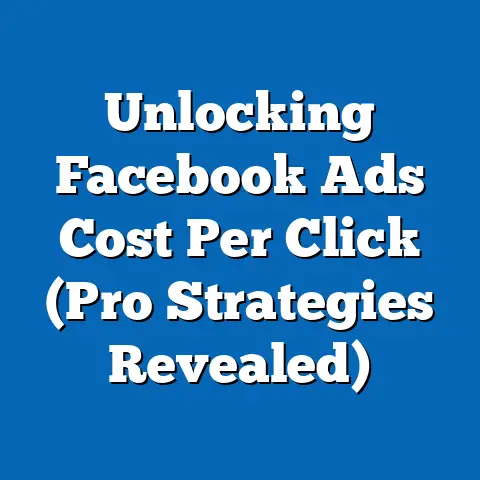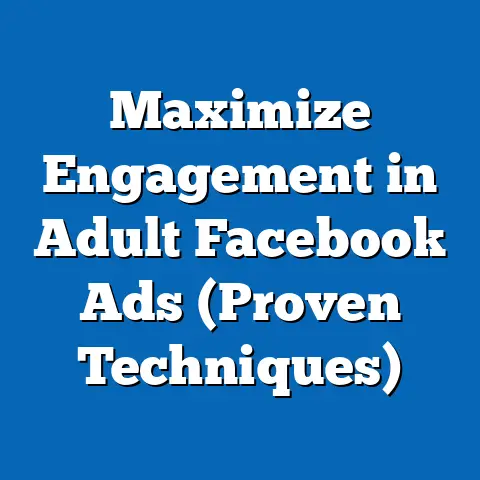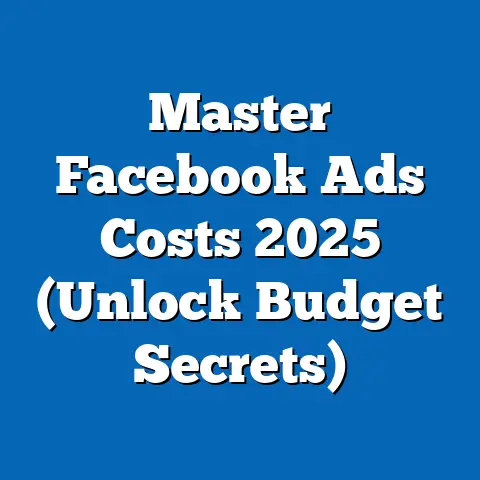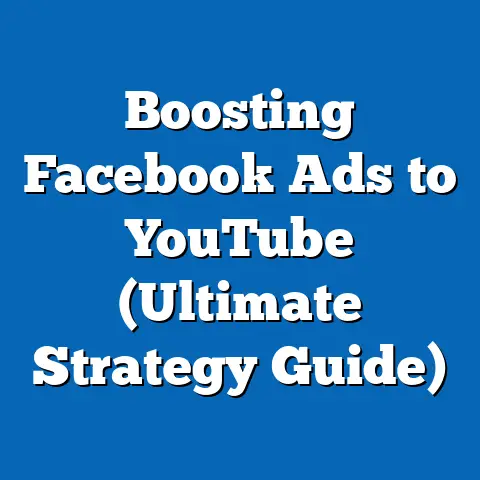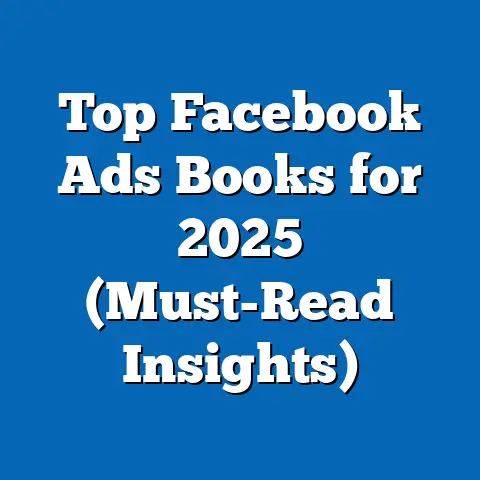Maximize Chacos Sales with Facebook Ads (Proven Strategies)
There is a pervasive misconception in the digital marketing world that Facebook Ads are no longer effective, especially for niche brands like Chaco, a company renowned for its durable outdoor sandals. Many marketers assume that younger demographics have abandoned the platform for newer social media giants like TikTok and Instagram, rendering Facebook Ads obsolete. However, this overlooks the platform’s vast user base—over 2.9 billion monthly active users as of 2023 (Statista, 2023)—and its sophisticated targeting capabilities that can reach highly specific audiences, including outdoor enthusiasts and eco-conscious consumers who align with Chaco’s brand ethos.
Defining Characteristics of Chaco’s Target Audience
Chaco, founded in 1989, has built a loyal following among outdoor adventurers, environmentally conscious individuals, and those who value durability and sustainability in their footwear. The brand’s target audience typically spans across multiple generations, including Millennials (born 1981-1996) and Gen X (born 1965-1980), who often prioritize quality and functionality, as well as some younger Gen Z consumers (born 1997-2012) drawn to the brand’s commitment to sustainability. According to a 2022 survey by Outdoor Industry Association, 68% of outdoor enthusiasts fall within the 25-44 age range, a demographic heavily active on Facebook despite assumptions to the contrary.
This audience is characterized by a love for adventure, whether through hiking, camping, or water sports, and a preference for brands that align with their values. Chaco’s focus on repairable, long-lasting products and partnerships with environmental initiatives resonates deeply with this group. Understanding these characteristics is crucial for crafting Facebook Ad campaigns that speak directly to their interests and needs.
Moreover, the diversity within Chaco’s audience—ranging from urban dwellers seeking weekend escapes to rural residents living an outdoor lifestyle—requires nuanced messaging. Not all customers are the same, even within the same generational cohort, and effective ads must account for varying motivations, from seeking rugged performance to embracing a “green” lifestyle. This complexity underscores the importance of leveraging Facebook’s detailed targeting tools to segment and personalize ad content.
Historical Context: The Evolution of Facebook Ads and Chaco’s Market Position
Facebook launched its advertising platform in 2007, initially offering basic ad formats like sidebar banners. Over the next decade, it evolved into a powerhouse with advanced features such as Custom Audiences, Lookalike Audiences, and dynamic product ads, driven by its acquisition of user data and machine learning algorithms. By 2023, Facebook Ads Manager provided unparalleled insights into user behavior, allowing brands to target based on interests, demographics, and even specific life events—a critical advantage for niche brands like Chaco.
Chaco’s own history parallels this digital evolution. Founded by a rafting guide, Mark Paigen, the brand initially gained traction through word-of-mouth among outdoor communities in the late 1980s and early 1990s, a time when Gen Xers were coming of age and embracing adventure sports. The 2000s saw Chaco expand its reach as Millennials, shaped by the rise of the internet and social media, became a key market, drawn to the brand’s authenticity and durability during a period of economic uncertainty following the 2008 recession.
Significant events like the growing environmental movement in the 2010s further shaped Chaco’s identity, as the company introduced initiatives like the ReChaco program for sandal repairs, appealing to eco-conscious consumers across generations. Meanwhile, Facebook’s ad platform matured, offering tools to target these very consumers through interest-based categories like “outdoor recreation” and “sustainability.” This historical synergy between Chaco’s brand evolution and Facebook’s advertising capabilities sets the stage for effective modern campaigns.
Societal Implications: Digital Marketing in a Hyper-Connected World
The use of Facebook Ads for a brand like Chaco carries broader societal implications, particularly in how digital marketing shapes consumer behavior and cultural values. In a hyper-connected world, targeted advertising can amplify a brand’s message of sustainability and community, resonating with societal shifts toward environmental responsibility—a core value for many of Chaco’s customers. However, it also raises concerns about data privacy, as Facebook’s targeting relies on extensive user information, a point of contention following scandals like Cambridge Analytica in 2018.
For Chaco, leveraging Facebook Ads means navigating a fine line between personalized marketing and respecting consumer privacy. The brand’s audience, particularly Millennials and Gen Z, values transparency and ethical practices, with 73% of Millennials willing to pay more for sustainable products (Nielsen, 2021). Ads that highlight Chaco’s commitment to reducing waste through repair programs, while avoiding overly intrusive targeting, can strengthen trust and loyalty.
Additionally, the societal trend of “digital fatigue” among younger users, who may feel overwhelmed by constant online ads, necessitates creative, authentic content that stands out. Chaco’s campaigns must reflect genuine storytelling—showcasing real customers on real adventures—rather than generic sales pitches. This approach not only drives sales but also contributes to a cultural narrative of meaningful consumption over fast fashion.
Technological Factors: Harnessing Facebook’s Ad Tools for Chaco
Facebook’s advertising platform offers a suite of technological tools that can be tailored to maximize Chaco’s sales. Dynamic Product Ads (DPAs), for instance, allow Chaco to automatically showcase specific sandal models to users who have previously visited their website or shown interest in similar products. A 2022 case study by Meta revealed that DPAs can increase return on ad spend (ROAS) by up to 34% for e-commerce brands, a promising statistic for Chaco’s online store.
Another critical tool is Lookalike Audiences, which enables Chaco to target users similar to their existing customers based on purchase history or engagement data. For a niche brand, this feature expands reach without diluting relevance, ensuring ads are shown to individuals likely to share the same outdoor and sustainability interests. Combining this with interest-based targeting—such as users who follow outdoor magazines or environmental nonprofits—further refines the audience.
Video ads also play a pivotal role, given their high engagement rates on Facebook. With 85% of users watching videos with sound off (Digiday, 2021), Chaco should prioritize visually striking content with captions, showcasing sandals in rugged terrains or repair workshops. The platform’s algorithm favors content that keeps users engaged, so optimizing for mobile-first, short-form videos (15-30 seconds) can boost visibility and conversions.
Economic Factors: Balancing Ad Spend and ROI for Chaco
From an economic perspective, Facebook Ads offer a cost-effective solution for Chaco compared to traditional advertising or even other digital platforms like Google Ads, where competition for outdoor-related keywords can drive up costs. The average cost-per-click (CPC) on Facebook in 2023 was $0.97, significantly lower than Google’s $2.69 for e-commerce keywords (WordStream, 2023). For a mid-sized brand like Chaco, this affordability allows for experimentation with different ad formats and audiences without breaking the budget.
However, economic conditions such as inflation and reduced consumer spending in 2023 pose challenges. Outdoor gear, while often seen as essential by enthusiasts, can be a discretionary purchase for casual buyers. Chaco’s ad strategy must therefore focus on value-driven messaging—emphasizing durability and repairability as cost-saving features over time—while offering limited-time discounts or bundles to incentivize immediate purchases.
Moreover, tracking return on investment (ROI) is critical. By integrating Facebook Pixel on their website, Chaco can measure conversions directly attributable to ads, adjusting campaigns in real-time to optimize spend. A balanced approach—allocating budget to both top-of-funnel awareness ads (e.g., storytelling videos) and bottom-of-funnel conversion ads (e.g., product carousels with discounts)—ensures a sustainable economic model for ad spending.
Social and Cultural Factors: Crafting Resonant Campaigns
Socially and culturally, Chaco’s audience is influenced by a growing emphasis on experiences over possessions, particularly among Millennials and Gen Z. A 2021 Eventbrite survey found that 78% of Millennials prefer spending money on experiences like travel or outdoor activities rather than material goods. Chaco’s ads should tap into this trend by framing sandals as enablers of adventure, using user-generated content (UGC) to show real customers on trails or rivers.
Cultural values around sustainability also shape ad messaging. With climate change as a pressing concern—evidenced by 2023’s record-breaking wildfires and floods—Chaco’s commitment to reducing environmental impact through repair programs and recycled materials can be a powerful differentiator. Ads highlighting these initiatives, paired with partnerships with environmental organizations, can appeal to the 66% of global consumers willing to change purchasing habits for sustainability (McKinsey, 2022).
However, cultural nuances within generations must be considered. While Gen X may respond to nostalgia-driven ads referencing the brand’s rafting roots, Gen Z prefers authenticity and humor, often engaging with memes or influencer content. A multi-pronged approach—testing different creative styles across audience segments—ensures broad appeal without alienating any group.
Proven Strategies for Maximizing Chaco Sales with Facebook Ads
-
Segmented Targeting for Personalized Messaging
Utilize Facebook’s detailed targeting options to create audience segments based on demographics, interests, and behaviors. For instance, target Gen X parents with family-friendly outdoor content, while appealing to Gen Z with trendy, sustainability-focused visuals. A/B testing ad copy and imagery for each segment can identify the most effective combinations, improving click-through rates (CTR) and conversions. -
Leverage User-Generated Content (UGC)
Encourage customers to share photos or videos of their Chaco sandals in action, offering incentives like discounts or contest entries. Repurpose this UGC in ads to build trust and authenticity—key drivers for 92% of consumers who trust peer recommendations over brand content (Nielsen, 2019). UGC also reduces content creation costs while increasing engagement. -
Dynamic Retargeting Campaigns
Implement Dynamic Product Ads to retarget users who have visited Chaco’s website or abandoned their carts. Showcasing the exact products they viewed, paired with a limited-time offer, can recover lost sales. Meta reports that retargeting campaigns can achieve a 760% higher click-through rate compared to standard ads, making this a high-impact strategy. -
Seasonal and Event-Based Campaigns
Capitalize on peak outdoor seasons (spring and summer) and events like Earth Day to run themed campaigns. For Earth Day, Chaco could highlight its sustainability efforts with a campaign donating a portion of sales to environmental causes, driving both sales and brand affinity. Scheduling ads around holidays or major outdoor events ensures relevance and urgency. -
Video Storytelling for Emotional Connection
Invest in short, captivating video ads that tell stories of adventure and sustainability. Feature real customers or influencers in authentic settings—hiking trails, riverbanks, or national parks—to evoke emotion and aspiration. Optimize for mobile viewing with captions and clear calls-to-action (CTAs) like “Gear Up for Your Next Adventure.”
Comparative Analysis: Facebook Ads vs. Other Platforms for Chaco
While Instagram, owned by Meta, shares many of Facebook’s targeting capabilities and boasts a younger user base, its ad costs are often higher, with an average CPC of $1.23 compared to Facebook’s $0.97 (WordStream, 2023). Instagram’s visual focus suits Chaco’s aesthetic, but its audience skews heavily toward Gen Z, potentially missing older, high-value customers like Gen Xers who are more active on Facebook.
TikTok, meanwhile, offers viral potential with its short-form video content, but its user base is predominantly Gen Z, and ad costs can fluctuate widely based on trends. For Chaco, TikTok may complement Facebook as a secondary platform for brand awareness, but it lacks the granular targeting and conversion tracking that Facebook provides for direct sales.
Google Ads, while effective for search intent, often requires higher budgets for competitive keywords like “outdoor sandals,” making it less cost-effective for niche brands. Facebook’s strength lies in its ability to build community and engagement alongside conversions, aligning with Chaco’s brand values more seamlessly than search-based platforms.
Implications for Chaco and Broader Society
For Chaco, a successful Facebook Ads strategy can drive not only sales but also brand loyalty, reinforcing its position as a leader in sustainable outdoor footwear. By reaching diverse generational cohorts with tailored messaging, the brand can expand its market share while maintaining its niche authenticity. Workplace implications include the need for marketing teams to upskill in data analytics and creative storytelling to execute these campaigns effectively.
Societally, Chaco’s use of Facebook Ads contributes to the broader narrative of digital marketing as a tool for purpose-driven brands. By prioritizing transparency and ethical advertising, Chaco can set a precedent for how niche companies engage with conscious consumers, potentially influencing industry standards. However, the reliance on user data for targeting must be balanced with privacy considerations to maintain consumer trust in an era of increasing scrutiny.
Culturally, these campaigns can amplify the importance of outdoor experiences and sustainability, encouraging a shift away from disposable fashion. Yet, they also risk contributing to ad saturation if not executed thoughtfully, potentially alienating audiences already overwhelmed by digital content.
Forward-Looking Insights: The Future of Chaco’s Facebook Ad Strategy
Looking ahead, Chaco must remain agile as Facebook’s platform and user behaviors evolve. The rise of artificial intelligence in ad optimization—such as Meta’s Advantage+ campaigns—offers opportunities to automate and enhance targeting, potentially increasing ROAS. However, uncertainties around data privacy regulations, such as potential expansions of the European Union’s GDPR globally, could limit targeting capabilities, requiring Chaco to invest in first-party data collection like email lists or loyalty programs.
Additionally, generational shifts will shape future strategies. As Gen Z becomes a larger portion of Chaco’s audience, integrating trends like interactive ads or gamification could maintain relevance, even if their presence on Facebook wanes. Conversely, retaining older customers through value-driven, nostalgic content will remain critical as economic pressures persist.
Finally, Chaco should monitor emerging platforms and technologies, such as augmented reality (AR) for virtual try-ons, which Facebook is beginning to integrate. While the future is uncertain, a commitment to authenticity, data-driven decision-making, and cultural resonance will ensure Chaco’s Facebook Ads remain a powerful tool for sales and brand growth.
Conclusion
Maximizing Chaco sales through Facebook Ads is not only feasible but also strategically advantageous, countering the misconception that the platform is outdated. By understanding the defining characteristics of their multi-generational audience, leveraging historical synergies between the brand and digital advertising, and addressing societal implications, Chaco can craft campaigns that resonate deeply. Technological tools, economic considerations, and cultural trends further inform proven strategies—from segmented targeting to dynamic retargeting—that drive measurable results.
While challenges like digital fatigue and privacy concerns persist, the opportunities for authentic storytelling and community-building on Facebook are immense. As Chaco navigates future uncertainties, a balanced, innovative approach to Facebook Ads will position the brand for sustained success, reinforcing its role as a champion of adventure and sustainability in a crowded digital landscape.

